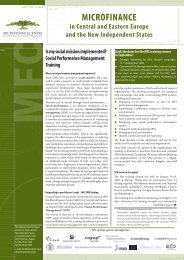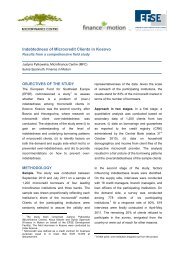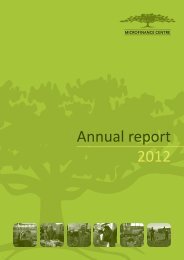Value Chains research report Tajikistan final - Microfinance Centre
Value Chains research report Tajikistan final - Microfinance Centre
Value Chains research report Tajikistan final - Microfinance Centre
You also want an ePaper? Increase the reach of your titles
YUMPU automatically turns print PDFs into web optimized ePapers that Google loves.
As it shown in table 36, more than 1,5 thousand tonnes of lemons were produced<br />
in <strong>Tajikistan</strong> in 2009 with lemon production concentrated in Khatlon Region. The<br />
productivity of lemons is different among the regions of <strong>Tajikistan</strong> and is dependent on<br />
the age of plants, maintenance of trees, pruning and fertilization. Some farmers can<br />
collect 15kg of lemons from one tree on average while others receive approximately<br />
40kg per tree. Mutavali Soliev, Chief Agronomist for the Zonal Experimental Station of<br />
Subtropical Plants, <strong>report</strong>s that yields could be as high as 1,500 lemons per tree.<br />
The cost of production of lemons is lower in comparison to other crops which are<br />
grown in greenhouses. However, it greatly exceeds the cost of production of fruits<br />
grown in the field. First households must invest in the greenhouse building and then on<br />
planting with three years between planting and economically viable yields. Further, as<br />
the plant bears fruits it starts to cover the expenses for acquisition of polyethylene<br />
cover, fertilizers, means of plant protection and payment for watering. During full<br />
production of lemons, the profit from selling lemons starts to repay the invested capital.<br />
Plant care does not take a significant amount of time.<br />
Plants do not survive through the winter if not properly cared for. Freezing is a<br />
major problem as evidenced in 2008 when 70% of lemon greenhouses of <strong>Tajikistan</strong><br />
suffered losses. Most of the plants were cut down and replacements are just now<br />
starting to bear fruit. Other problems exist in lemon growing including:<br />
• High level of underground water,<br />
• Struggle against parasites and diseases, There are no prophylactic treatment<br />
activities. Farmers start taking care of plants only after finding diseases.<br />
• Out-of-date technologies for storing, and<br />
• Poor quality fertilizers and pesticides<br />
In spite of that problem production lemons is very popular and many farmers would like<br />
to establish that greenhouse production. During last 2 year it is became feasible and<br />
many new greenhouse was started.<br />
Lemon pickers can collect up to 30 crates of lemons a day. They are paid on<br />
average 3-4 Somoni per crate. If the fruit are collected for a lengthy storage, they are<br />
cut with scissors, keeping the stalk on the fruit. This extends the lemon’s shelf life.<br />
Commercial sorting and calibration service is not demanded, as lemons are sold<br />
by weight and the price depends on the average size of the fruit. Separating sorting,<br />
calibration and packaging into separate processes is not profitable at this stage of<br />
subsector development – as the markets ready to pay extra for this activity are not<br />
present yet. Before, this activity was performed by collection points, which delivered the<br />
lemons to the Republic of <strong>Tajikistan</strong>. Currently lemons are mostly produced for the<br />
domestic market, which is not ready to pay extra value for packaging. Calibration and<br />
sorting are performed by retailers as part of the pre-sale preparation. These processes<br />
are necessary if the channel for exporting lemons from the country is established.<br />
However, considering current production volumes, prices at farm level and the<br />
separation and independence of producers, this requires a lot of work. Prospective<br />
sales markets are Kyrgyzstan and Kazakhstan.<br />
75















